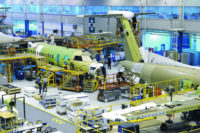CHICAGO—A new book entitled Made in Chicago (Arcadia Publishing) examines the important role that manufacturing played in the history and growth of the Windy City. Written by Austin Weber, senior editor of ASSEMBLY, the book contains hundreds of never-before-published photos gathered from a wide variety of sources.
Made in Chicago: The Windy City’s Manufacturing Heritage provides a look at long-forgotten companies such as Bell & Howell, Elgin Watch, EMD, Schwinn, Stewart Warner and Zenith. It illustrates what life was like inside the assembly lines, foundries, machine shops and steel mills that employed hundreds of thousands of Chicagoans who turned out an endless array of products every day.
The Chicagoland area was once a leading producer of agricultural equipment, bicycles, coin-operated arcade games, construction equipment, furniture, globes, jukeboxes, light fixtures, musical instruments, office equipment, power tools, radios, railroad cars, shoes, telephones, televisions, toys, watches and many other items. The book focuses on the years between 1872 and 1972, but it depicts manufacturing activity in the city dating back to 1847.
Products ranging from automobiles to printing presses and barbed wire to typewriters are included in the 128-page Made in Chicago book. Many types of assembly processes are featured, such as brazing, riveting, screwdriving, soldering, welding and wire harness production. In addition to photos, the book contains maps and vintage advertising.
Chapters include “Why Chicago?” and “Early Manufacturing in Chicago,” which explain how the city became a production powerhouse during the mid-19th century. The role of steel mills and metal fabrication shops is covered in a separate chapter entitled “City of Steel.”
Another chapter of Made in Chicago is devoted to the three largest manufacturers that once called the Windy City home and the products that they mass-produced for decades: International Harvester (farm equipment), Pullman (railroad cars) and Western Electric (telecommunications equipment).
A chapter entitled “Chicago’s Finest Hour” examines how the city’s factories were transformed into the “arsenal of democracy” during World War II. Local companies made the majority of all electronics and communications equipment used by the U.S. military. Other Chicago area manufacturers built tanks, trucks, torpedoes and other products that were used on land, sea and air.


